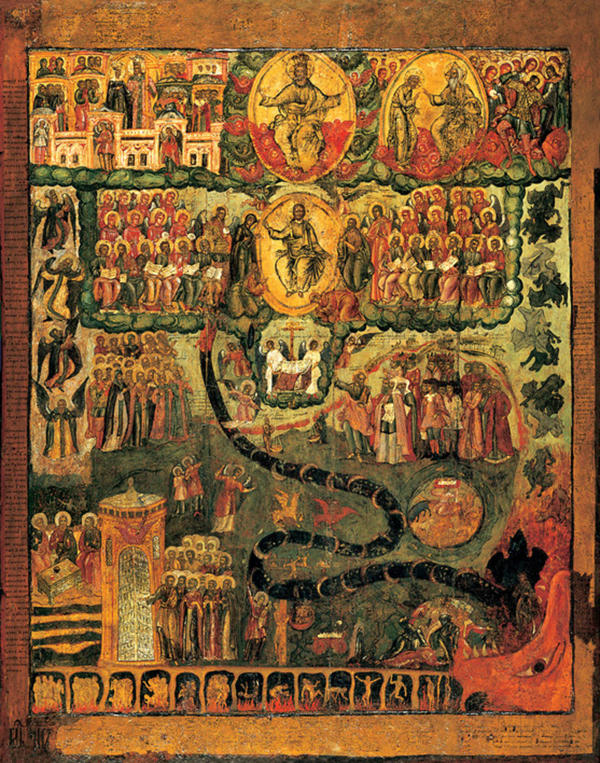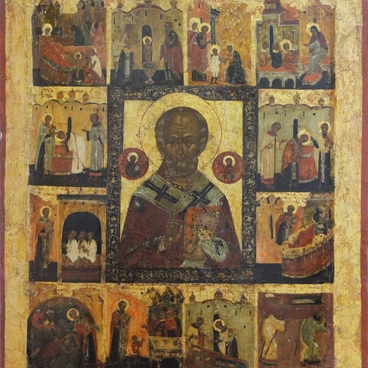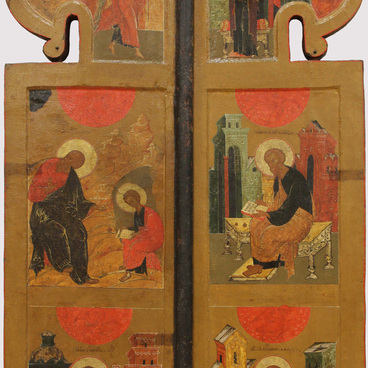The iconography of the Last Judgement stems from the texts of the Gospels and the last book of the New Testament, the Apocalypse. This part of the Bible is also called the Book of the Revelation of St. John the Divine, with the words of Jesus Christ noted down by St. John the Evangelist. The Bible offers very little information about St. John, apart from the note that John was on the island of Patmos where he had his first vision. He is therefore sometimes called St. John of Patmos. It is stated there that when Jesus returns, he will resurrect all who ever lived on earth and will pass judgement on them. Scholars believe that the frightening images of the Last Judgement, with their scenes of torments, was to help convince pagans to convert to Christianity. The earliest such icon in Russia, dating back to the 15th century, is now in the Assumption Cathedral of the Moscow Kremlin.
The Last Judgement
Creation period
Late 17th – early 18th century
Dimensions
189x140 cm
189х140х3.7 cm
189х140х3.7 cm
Technique
Wood, tempera
Exhibition
0
Open in app#1

Unknown Author
The Last Judgement
#2
#4
Vologda masters
#5
The Last Judgement icon from the collection of the State Museum of Fine Arts of Khanty-Mansiysk was painted in the late 17th — early 18th century by Vologda masters. Whereas the Vologda icon-painting school started to take shape in the 14th century, the local icons acquired their striking identity in the 15th century. They were distinguished by both the sophisticated manner of painting and the colour palette. By the 17th century the Vologda icon-painting acquired more intense tones and sharp lines from the Novgorod and Moscow schools.
#6
Iconography
#10
The last Judgement icon shows several scenes. In the upper tier there are two medallions, one with the Trinity, God the Father, God the Son and the Holy Spirit, and the other with Jesus Christ as judge. To one side of him is the land of the righteous, the Heavenly Jerusalem, to the other the army of angels. The middle part of the icon is filled with throngs of people waiting for their verdict. The icon master showed them in the then fashionable dress of both Western Europe and eastern provinces.
The lower part always depicts hell and the Satan holding Judas’s soul in his hands.
The icon has two distinct parts. The left one, on the right of Jesus, shows the righteous, their ascension to heaven and their souls in the gardens of Eden. Whereas sinners and their descent to hell are shown on the left of Jesus, which, for the viewer, is the right side of the icon.
The icon has two distinct parts. The left one, on the right of Jesus, shows the righteous, their ascension to heaven and their souls in the gardens of Eden. Whereas sinners and their descent to hell are shown on the left of Jesus, which, for the viewer, is the right side of the icon.
#9
Technique
#8
The icon was painted on a seasoned piece of wood, more commonly, lime, ash or another non-resinous species. The central image was originally painted inside the specially prepared recess, which in icon-painting is called a kovcheg. After some time, they stopped cutting back the central part of the icon, and this icon was painted without any such recess. The wood was covered with a linen cloth and a primer, levkas, a mixture of chalk, glue and oil. The frame was painted in ochre, a specially prepared paint made of rust and clay. The edge of the icon was traced with a red line, opush, which is missing in places.
The icon was housed in local churches until, in the 20th century, it ended up with Viktor Samsonov, a collector of Russian antiquities. It was bought from him by the Khanty-Mansy District’s Generation Foundation, which handed it over to the museum in 2011.
The icon was housed in local churches until, in the 20th century, it ended up with Viktor Samsonov, a collector of Russian antiquities. It was bought from him by the Khanty-Mansy District’s Generation Foundation, which handed it over to the museum in 2011.
#11
State Museum of Fine Arts of Khanty-Mansiysk
read morehide
00:00
00:00
1x
The Last Judgement
Creation period
Late 17th – early 18th century
Dimensions
189x140 cm
189х140х3.7 cm
189х140х3.7 cm
Technique
Wood, tempera
Exhibition
0
Open in app
Share

